Houston’s mild climate and diverse landscapes make it a perfect spot for birdwatching. From vibrant songbirds to striking woodpeckers, your backyard can attract a variety of feathered friends. In this guide, we’ll explore the common backyard birds in Houston, helping you identify and enjoy these beautiful visitors.
Table of Contents
Northern Cardinal
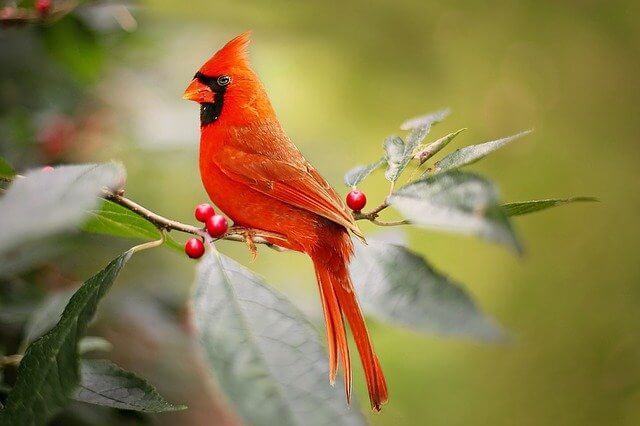
The Northern Cardinal is found in southern Canada, including British Columbia, Manitoba, Ontario, Minnesota, and Washington, through the central United States from Oregon to Texas, and west through Mexico, Guatemala, and Honduras.
The northern cardinal lives in many types of habitats, in forests and swamps, on mountaintops, and in thick brush. They are active throughout the year, with the most abundant activity occurring during the winter months, from early November to late January.
They may be seen flying throughout most parts of North America, particularly when birds are breeding, but are particularly abundant in southern Canada during migration.
- Frequency: 66%
- Color: Mostly red throughout, with a black mask on the face
- Habitat: woodlands, gardens, parks, backyards, and wetlands
- Range: USA, Canada, Mexico
- Size: 8.2 – 9.3″ inches
- Weight: 33 – 65 grams
- Diet: Fruits, berries, and insects (grasshoppers, beetles, snails, cicadas)
- Family: Cardinalidae
- Genus: Cardinalis
Related Posts
Northern Mockingbird
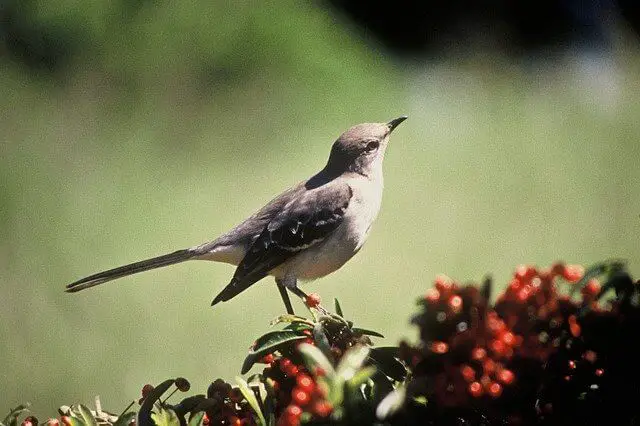
The Northern Mockingbird is probably the most commonly seen mockingbird in North America, making it an extremely popular to observe. This bird is mostly a resident, although some species may migrate south at times of extreme weather.
They usually nest on the ground or in low trees in areas with abundant food supply. They feed on a variety of small insects, as well as small carrion and other smaller animals like frogs and mice.
In addition to this, some species of the Northern Mockingbird hunt in packs, attacking large birds and killing them. This is very common in places where there are large flocks of migratory birds.
- Frequency: 47%
- Color: Gray upper with white underparts. Black and white wing bars.
- Habitat: Forested areas, parks, and gardens
- Range: Southeastern Canada, USA, Northern Mexico, Cayman Islands, Greater Antilles
- Size: 8.0 – 11″ inches long
- Weight: 40 – 58 grams
- Diet: Berries, fruits, seeds, arthropods, earthworms, and occasionally lizards
- Family: Mimidae
- Genus: Mimus
Related Post: How to Attract Northern Mockingbirds to your yard?
Blue Jay

The Blue Jay are passerine birds belonging to the family Corvidae, native to central and eastern North America, particularly during spring. It lives primarily through the east and central United States and Canada, though it may also migrate southward.
It can be seen throughout North America in spring, especially in the southern states of Arkansas, Kansas, Louisiana, Missouri, Nebraska, Oklahoma, and Texas.
In the fall, the blue jay will migrate southward again, though it may spend wintering as far north as the northern states of Minnesota, Wisconsin, and Michigan. It is the most widely distributed in the United States; it also occurs in Canada and Europe.
- Frequency: 46%
- Color: Has a blue crest on its head, blue wings, back, and tail, and has a white face and belly.
- Habitat: Deciduous and mixed forests, mixed woodlands, backyards, parks
- Range: Southern Canada, Eastern and Central United States, Florida and Texas
- Size: 8 – 12″ inches
- Weight: 70 – 100 grams
- Diet: Nuts, seeds, caterpillars, grasshoppers, and beetles
- Family: Corvidae
- Genus: Cyanocitta
Related Posts:
- How to Attract Blue Jays to your Yard?
- Do Blue Jays Migrate? The Truth
- What do Blue Jay Eat – All The Facts
- 15 Best Bird Feeders for Blue Jays
Tufted Titmouse
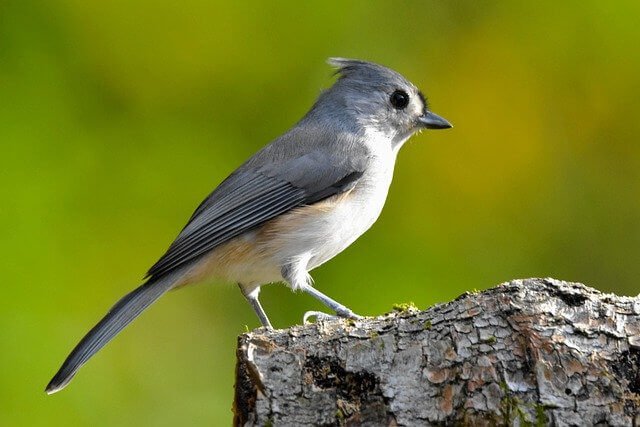
The tufted Titmouse is an uncommon songbird in North America, which is part of the chickadee and tit family. It is found in central and south Texas southward; in some parts of Texas, it is called the black-necked titmouse. It is known from Mexico as the tufted titmice, and in Central America as the tufted crown titmice.
The common name for this small songbird is tufted titmice. The tufted Titmouse prefers a moderate climate with a warm summer. The song of the Tufted Titmouse is often described as having a rich, full, “richly modulated” sound.
It has three primary and two secondary chords. The song varies considerably in different seasons, but is generally more attractive in the spring and summer season.
- Frequency: 44%
- Color: Gray upper body, white chest and belly, with a tufted gray crest on the head.
- Habitat: Deciduous forests, river basin, backyards, swamps
- Range: Canada, USA, and Mexico
- Size: 5.5 – 6.4″ inches
- Weight: 18 – 26 grams
- Diet: Nuts, insects, berries, seeds small fruit, and snails
- Family: Paridae
- Genus: Baeolophus
Related Post: How to Attract Tufted Titmouse to my Yard?
Carolina Wren
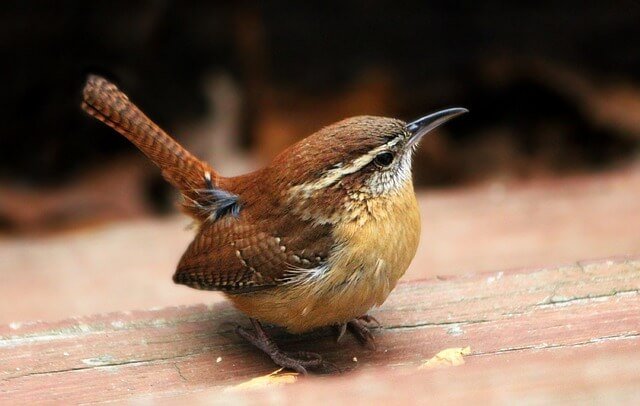
The Carolina Wren is actually very common species of wren, which is actually a native resident of the far south of North America, mostly in the east coast of Canada, New Jersey, and the far northwest part of the USA.
The Carolina wren has become a very popular resident on many backyards and even on the lawns of apartment buildings and condominiums all across the world.
They will breed in any habitat in the world that has a moderate amount of shade and is abundant with food. The most common way to spot a Carolina Wren is with its beautiful white chest. They are mostly reddish brown.
Some people are really not to sure why the Carolina Wren only sings to scare off other birds. It is said that it is very effective at doing this, although the truth is that it isn’t exactly clear why. They are known to be very vocal and if they sense that there are other birds around that are also singing it will try to discourage them and get away from them.
- Frequency: 41%
- Color: Reddish-brown upper body, and buff-orange color under, with a white chin, throat. White stripe on the eyebrow.
- Habitat: woodlands, gardens, parks, backyards, and wetlands
- Range: USA, Canada, Mexico
- Size: 5.0 – 5.5″ inches long
- Weight: 18 – 23 grams
- Diet: Eats fruits, berries seeds, and insects (Caterpillars, beetles, true bugs, grasshoppers, crickets, spiders, millipedes, snails)
- Family: Troglodytidae
- Genus: Thryothorus
Related Post: How to Attract Wrens to your Backyard
Red-bellied Woodpecker

The Red-bellied Woodpeckers are medium-sized woodpeckers of the genus Picidae. It breeds primarily in the southern United States, varying from south to mid-west to north as far as Canada.
It is known for its vibrant colors that come in varied hues from orange, red, green, yellow, and black. Other distinguishing features are an unusually long bill, short tail, and a prominent “face” on their upper chest.
They are very territorial, nesting in cavities near their nest in trees and shrubs in order to protect it from other specie’s nest. They have no permanent territory as the species can be found all over North America.
Both sexes prefer food items such as seeds and insect larvae. Red-bellied Woodpeckers’ song is loud, sweet, and relatively high-pitched, with a deep, ringing, and flapping sound resembling a cricket’s chirp.
- Frequency: 40%
- Color: Gray on body and face and underparts. Black and white pattern on wings, back, and tail.
- Habitat: Forests, backyards
- Range: Southern Canada, Eastern United States, Florida
- Size: 9 – 10.6″ inches long
- Weight: 56 -91 grams
- Diet: Insects, small fish, oozing sap, tree frogs, and eggs of small birds.
- Family: Picidae
- Genus: Melanerpes
Related Post: How to Attract Red-bellied Woodpeckers to your Yard?
Carolina Chickadee
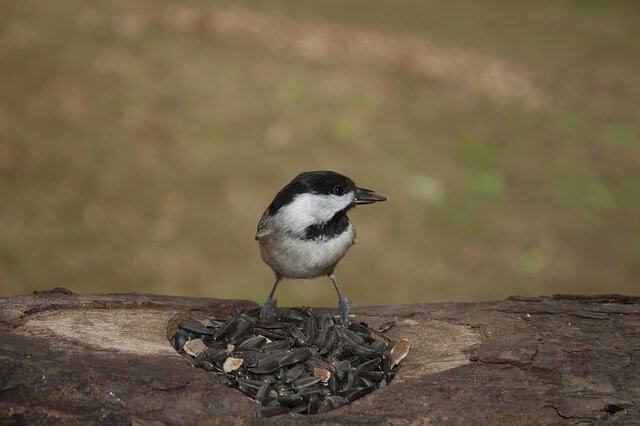
The Carolina Chickadee is actually a subspecies of the common chickadee. It is generally classified into two genera – the Northern Pied Cowbird and the Southern Pied Cowbird. The Carolina Chickadee is, however, a separate species from the Pied Cowbird. It is known to be in the Genus Parus with all other tit relatives, including the other tit families.
It is believed that Carolina Chickadees is part of a larger group called the Pied Flycatchers, which is native to central and eastern North America. They feed primarily on insect larva.
A number of species occur in large numbers along the coasts of Alabama, Mississippi, and Georgia. It is generally accepted that the common Chickadee has its common habitat from southern Mexico north to the northernmost states of Canada and Alaska.
- Frequency: 36%
- Color: Black cap and throat with white cheeks. Light gray wings, back, and tail.
- Habitat: Deciduous forests, suburbs, parks, backyards
- Range: USA ( New Jersey, Florida, Texas, and Kansas)
- Size: 4.5 – 5.1″ inches long
- Weight: 9 – 12 grams
- Diet: Insects, berries, seeds
- Family: Paridae
- Genus: Poecile
Related Post: How Do I Attract Chickadees To My Yard
House Finch

The house finch is an ornithological gem from the avian family Fringilla. It is native to Central and Western North America and was brought into the eastern half of its range and Hawaii and the west coast of Mexico.
There are five subspecies of house finches and this includes the common house finch. This is not to say that the common house finch does not occur in the southern part of the United States, because it does.
However, they are more commonly found in California and the Gulf coast states. This bird has become a popular due to the beautiful coloring on its body, with orange or yellowish shades all over its body and head.
- Frequency: 33%
- Color: They have a reddish face and upper breast, brown streaks on the belly, back, and tail.
- Habitat: They are found in the urban and suburban areas, yards, edges, backyards, and parks.
- Range: Canada, USA, Mexico
- Size: 5 – 6″ inches
- Weight: 16 – 27 grams
- Diet: Aphids, grains, seeds, berries, nettle, dandelion, sunflower
- Family: Fringillidae
- Genus: Haemorhous
Related Post: How to Attract House Finch to your Yard
Eastern Bluebird
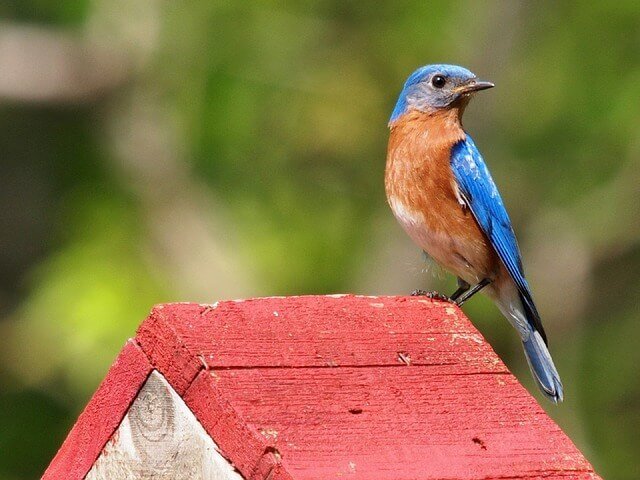
In spite of its size, the Eastern Bluebird is an American migratory little bluebird is generally found in North America, though it has a tendency to migrate south for some months of the year. They are also known to travel to the Caribbean, and South Africa.
Though the little bluebird breeds from all around the world, it is believed that it is rare in some areas, such as the Central Pacific, and they are found in open woodlands, farmlands, and orchards. Though it has the distinction of being the smallest of the bird species, it has been known to be quite loud in its song.
It has also been known to emit a number of sounds, including chirps and twitters, and is known to make a series of chirping noises when flitting around in the air. It is believed that this bird also uses its song to attract mates, and mates it mates with different birds of the same species in order to mate.
- Frequency: 25%
- Color: A Blue head, back, and wings. reddish-brown breast
- Habitat: Open woodlands, farmlands, and orchards.
- Range: Southern Canada all the way down to the Gulf states, East of the Rockies, and south to Arizona to Nicaragua
- Size: 5.5 – 7.1″ inches in length
- Weight: 20 – 33 grams
- Diet: insects and other invertebrates
- Family: Turdidae
- Genus: Sialia
Related Posts:
Downy Woodpecker
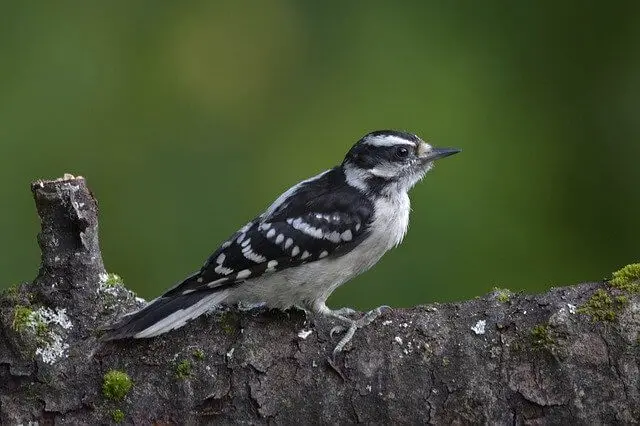
The Downy Woodpeckers is a subspecies of the American Woodpeckers that is native to the Central and Northern United States. The Downy Woodpeckers is the third-smallest in North America.
It is also called the Downy Woodpecker, because it has a grayish brown body, light underwing coverts, and white chest. It has a short bill and small forewing. Its wings are broad and long with large and prominent black patches. Their head is relatively short, almost triangular, with a short narrow crest.
This woodpecker is very colorful and has a great songbird call. It does not have a flight membrane unlike most other birds. Its body has a very distinct white ring around the eye and an irregular white ring in its chest.
- Frequency: 21%
- Color: Black with a white throat, belly, and back. White spots on wings
- Habitat: Deciduous forests and thickets, roadside, grasslands, backyards, parks
- Range: Canada, USA, and Mexico
- Size: 5.5 – 7.1″ inches in length
- Weight: 20 – 33 grams
- Diet: East mostly insects such as ants, beetles, gall wasps, and caterpillars
- Family: Picidae
- Genus: Dryobates
Related Posts: How to Attract Downy Woodpeckers: Expert Tips!
Frequently Asked Questions
What is the largest bird in Texas?
The whooping crane is the largest bird in Texas. It’s also the tallest North American bird, standing up to five feet tall. Whooping cranes have a wingspan of seven and a half feet. They weigh about twenty pounds and can live up to 2 to 4 years old in the wild or 9 years old in captivity.
What is the most common bird in South Texas?
The Northern Cardinal is the most common bird in south Texas, with a frequency of occurrence of 66%. This is due to their aggressive, territorial nature. This bird’s habitat ranges from Oklahoma to Florida and into central Mexico. This bright red bird can be found year-round in yards, woodlands, orchards, parks and gardens.
What is the bird of Texas?
The Northern Mockingbird is the bird of Texas. It is a common resident throughout the state, and it inhabits a variety of habitats, from open prairies to semi-arid scrublands. In fact, these birds are found in every habitat in Texas except for high elevation pine forests.
What is the largest hawk in Texas?
The Ferruginous Hawk is the largest hawk in Texas. They are found throughout the country, but more so in Texas than anywhere else. It has a wingspan of 5 feet and its height is just over 2 feet tall. The weight ranges from 2 to 4.5 pounds. This bird lives primarily on rabbits and mice and can be seen flying high above ground level hunting for prey.
What Texas bird has a yellow breast?
The yellow-breasted chat is a common Texas bird with a distinctive yellow breast. These birds are also found in other states including Oklahoma, Arkansas, and Louisiana. It is seen in Texas during the months of April and September.


